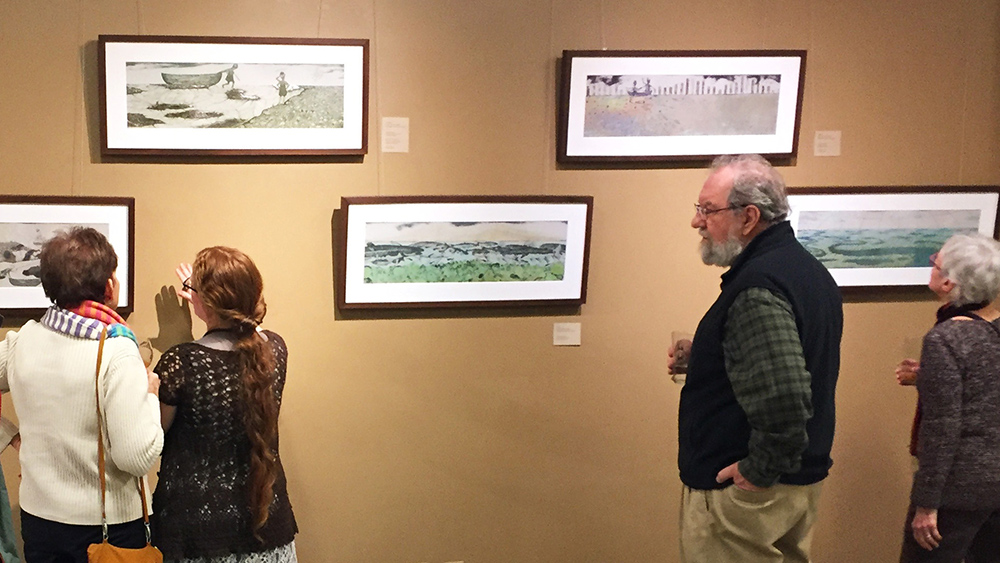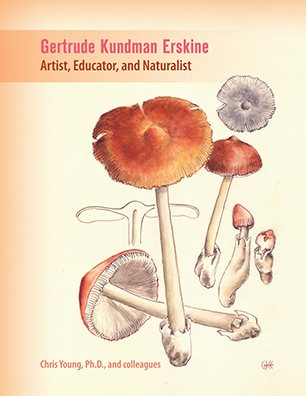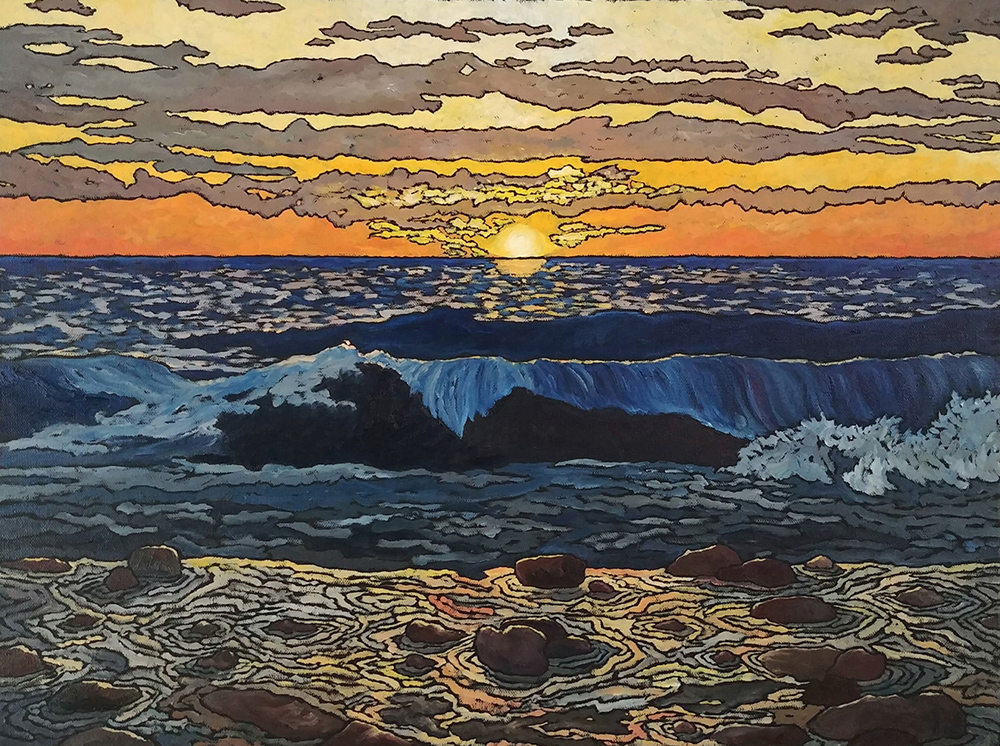
Art and Ecology
January 7, 2019 | Topics: featured artist, Spotlight
By Nancy Aten

”How Strong is an Ant”, a series of science and nature illustrations for picture books, by Carol Schwartz, at UEC April – June 2016. Courtesy of the artist.
As one of a multitude of valued volunteers, my connection with the Urban Ecology Center is through art. In support of the Center’s mission – which is to connect people in cities to nature and each other – I’m interested in art as a catalyst.
When the Urban Ecology Center facility in Riverside Park was completed in 2004, board member Danni Gendelman had the idea to host nature-related art exhibitions in the Community Room. From its beginnings, a volunteer Art Committee of local artists and arts professionals decided to mount quarterly exhibitions of locally-connected, nature-based art.
These changing art exhibitions are on walls seen by almost every school class that visits the Center, by neighbors and families attending many of the Center’s community programs, and by groups who meet in the evenings. These are very visible walls in a place that encourages people to engage with nature outdoors and deepen their own understanding of it.

Poised, by Tyler Green, Minnesota, through interviews with restoration ecologist Kurt Ewing; at UEC April – June, 2014. “The print illustrates spikelets of three main plants Kurt used to restore the landfill. They’re rendered simply, standing in the foreground like comic book superheroes, which in a way they are. With help of course: Kurt, the wiseman, the teacher, is a small silhouette on the horizon. His wife would describe him as someone who is, “Grumpy, but gets stuff done.” The restored prairie is an example of that. Ecological restoration is a story of a bad situation turned good. A story with perils and laughter. Worthy of a comic book. The story of nature restored.” Courtesy of the artist.
As a member of the Art Committee, I have an underlying motive. I ask questions like this: can the art also help explain the life outdoors? Can it illuminate ecological processes and biological interactions? Can it enable the educators of the Urban Ecology Center to give their students an alternate conduit for understanding the ecology of a place? Can the art be examples of sketching and illustration whose methods educators can learn and use to explain (draw) the structure of a plant or the wings of a bird? (See Damsels and Dragonflies and Drawing). I want the Center’s art shows to be not just pictures on the wall, but a deep part of the Urban Ecology Center’s mission.
The first exhibition in the gallery, reports founding Art Committee member and artist Sally Duback, “featured the work of seven Madison area photographers who were granted the exclusive privilege of a two-year window at the Badger Ammunition Plant in Prairie du Sac to photograph anything and everything on its six-thousand-acre grounds. The Plant had been de-commissioned, was abandoned and in varying states of decay; so Mother Nature was taking over. At the time, the future of the site was a subject of some debate, so these photographs inspired some interesting discussions about the future of such a large tract of land in the heart of the environmentally sensitive Sauk Prairie. This made for a fascinating exhibition”.

Artist Cynthia Brinich-Langlois (second from left) shares stories of her lithographs, at UEC January – March 2016. “The relationship between people and the land they inhabit thematically connects my research. I emphasize the effects of human intervention in terms of altered topographies, cartographic systems of ordering space, and metaphorical interpretations of ecological systems. … The tadpoles and frogs present a visual metaphor for a world in flux. Frogs undergo dramatic physiological changes in their journey, sensitive to minute changes in the environment.” Photo: Nancy Aten

Exhibition catalogue cover for Tula Erskine’s work at the UEC October – December 2017. Courtesy of the artist.
A fascinating exhibition indeed. And also one that provided openings for thought and learning – for surprises, and the opportunity for individual discovery. This, to me, seems perfectly symbiotic with the learning going on at the Urban Ecology Center every day. Outdoors, one might first notice the pretty bloom of the Liatris, or Blazing Star, and a bit later, notice the patterning of those blooms on the hillside of the Arboretum; and later, maybe in a discussion with someone else, consider the ecology, processes and interactions that might be affecting those patterns. Art that embeds or embodies bits and pieces and stories of ecology – that might reveal ideas to each person in their own way – can enrich their experiences outdoors. That kind of possible unfolding in an art exhibit – that’s what I’m hoping for.
The Art Committee explores new paths, too. In 2017, the Center hosted an exhibit of botanical mushroom illustrations of the late artist and mycologist Tula Erskine, who lived in nearby Cambridge Woods (See Leaving a Legacy). The Art Committee produced an exhibition catalog for the first time and hosted an engaging talk by Alverno professor Chris Young about Tula’s work as a community scientist.
Two of the Center’s educators, Chad Thomack and Victoria Bahe, sometimes invite an exhibiting artist to meet with high school students at the Center to demonstrate methods and share ideas with the students. In a recent exhibit and special preview for the Center’s education staff, a guest used the found-object assemblages of artist Marly Gisser to teach a powerful way of talking with kids and adults about both art and science, called Visual Thinking Strategies, or VTS. We are always on the lookout for expanding our horizons in the synergy of art and ecology.

Calibration, one of Marly Gisser’s found-object assemblages, at the UEC October – December 2018. Courtesy of the artist.

Sunrise over Lake Michigan by Kelli Greentree, at the UEC with photographer Phyllis Bankier January – March 2019. Courtesy of the artist.
If you are an artist, we invite you to join us in expanding those horizons! Our annual Call for Artists is due January 20th, 2019. As a neighborhood-based organization in a diverse neighborhood, we strive to host artists reflecting that diversity and whose artwork resonates with our community. We seek artwork that helps the Center in its mission, to foster ecological understanding. Apply on the Urban Ecology Center website.
And please join us this Thursday, January 10th, 5-7 pm for the free opening reception for our newest exhibition, featuring artists Kelli Greentree and Phyllis Bankier. There will be refreshments, good company, and the artists will speak informally at 6 pm. The show runs January – March 2019.
Urban Ecology Center hours are Monday – Thursday, 9 a.m. – 7 p.m., Friday & Saturday, 9 a.m. – 5 p.m., Sunday, Noon – 5 p.m. The Center is located at 1500 E. Park Place, Milwaukee 53211, (414) 964-8505.
Nancy Aten is a landscape architect practicing ecological restoration and conservation planning at her firm Landscapes of Place LLC in Milwaukee.

